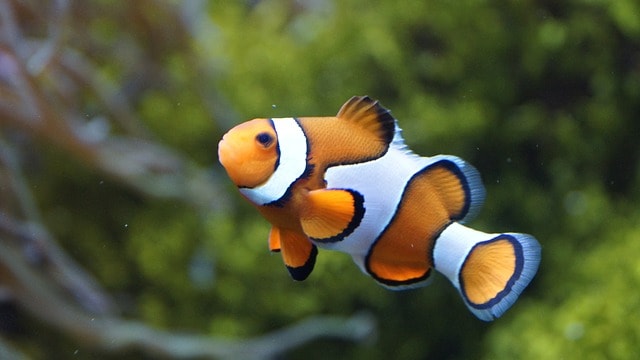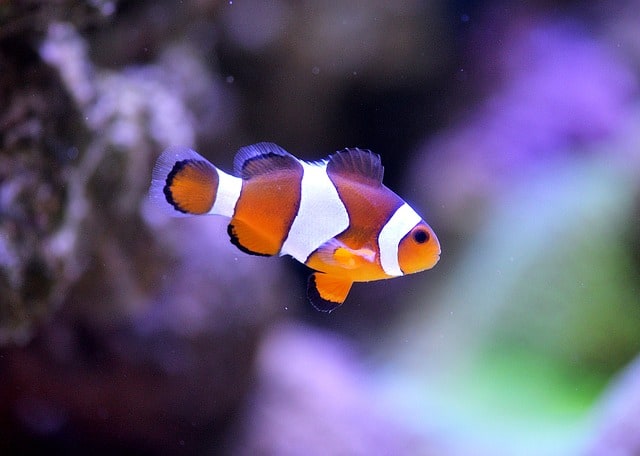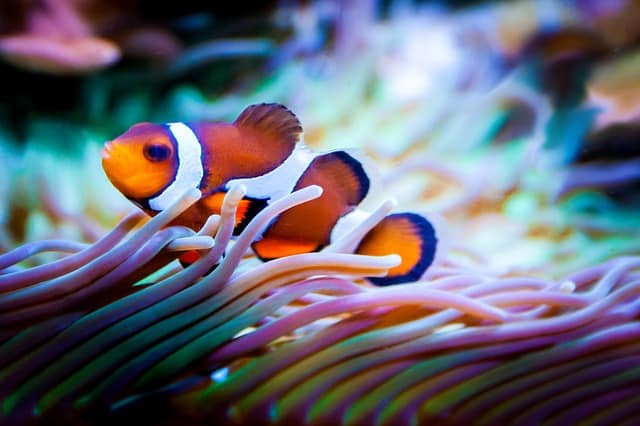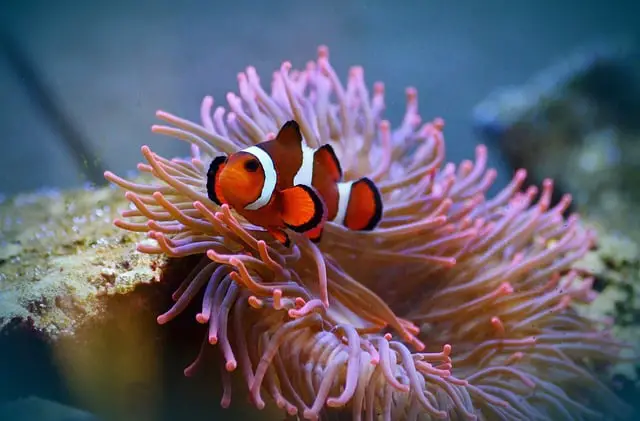Aiptasia infestation is a common problem with many saltwater aquariums, especially those with a reef setup. They attach themselves to (or ‘hitchhike’ on) live rocks or corals purchased at pet shops and can have a devastating effect on a tank containing corals if not eradicated quickly. So, how does one get rid of aiptasia?
The best and safest way to rid your reef tank of unwanted aiptasia naturally is to introduce a few peppermint shrimps. These little invertebrates won’t harm fish or corals yet have a voracious appetite for aiptasia. They also work hard to help keep their aquatic environment both clean and safe for all tank inhabitants.
Now that you know the addition of peppermint shrimp to a reef tank will go a long way in keeping it aiptasia-free, let’s take a closer look at this topic. Together we’ll learn what aiptasia is exactly, what causes it, why it’s bad for reef tanks, and how to get rid of it with and without the use of chemicals. We’ll also discover how other aquatic creatures like butterfly fish and sea slugs can help with this.
So, if you’re ready to learn more by ‘diving deeper’ into the different ways of preventing aiptasia from taking over your reef tank, then let’s get to it…
What is Aiptasia?
Aiptasia is a type of tropical anemone typically found living along mangrove roots and other hard surfaces in an aquarium. Aiptasia can reproduce asexually so just a single cell is all it takes for new polyps to form and grow. They’re usually clear to light brown in color and range in size from a few centimeters to a few inches.
How do You Identify Aiptasia in a Reef Tank?
Aiptasia anemones appear like tiny, brownish colored palm trees with a disc of tentacles around the top. At the center of the disc is a mouth which looks like an elongated opening or slit. There are at least 17 known species of aiptasia that you’ll usually find hiding in caves or along rock crevices in an aquarium. They may look harmless but if overlooked can have a detrimental effect on a reef tank.
Is Aiptasia Bad for a Reef Tank?
Aiptasia anemones aren’t good for marine aquariums because they have powerful stingers which can harm (and even kill) both corals and fish. They carry toxins that are often more potent and dangerous than most corals typically kept in reef tanks. They also reproduce at a rapid rate and can easily take over their aquatic environment if not managed.
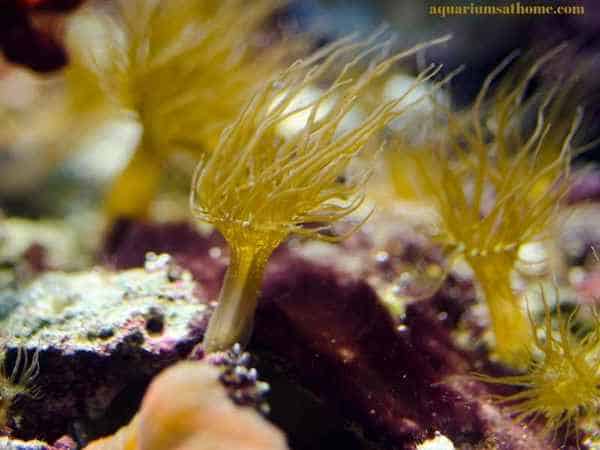
What Causes Aiptasia in a Reef Tank?
Aiptasia unknowingly enters a fish tank by ‘hitching a ride’ on a piece of live rock or by hiding along the bottom of a frag plug in some newly added coral. Since most species are tiny, they tend to go unnoticed until it’s too late and they’ve become established in your aquarium. They’re difficult to find and get rid of since they retreat into tiny holes when disturbed or threatened.
How do I Get Rid of Aiptasia in a Reef Tank?
Aiptasia specimens are tricky to remove from a reef tank. Because they can reproduce asexually from a single cell, it’s important not to crush them or scrape them off corals. This will only leave fragments of the organism behind to multiply and grow into full anemones.
The best way to rid your tank of small aiptasia is to stock it with peppermint shrimp. These invertebrates are omnivorous and will feast on both plant- and meat-based edibles in an aquarium including aiptasia. Hardy and easy to maintain, peppermint shrimp are also the one of the most peaceful reef crustaceans.
If you choose to introduce peppermint shrimp to your reef tank, make sure not to feed them until after they’ve eaten all the aiptasia in the tank first. If you offer these invertebrates an easy meal, they’ll opt for that instead of hunting and killing the aiptasia anemones which ultimately defeats the purpose.
Copperbanded butterfly fish are yet another option for ridding a reef tank of aiptasia. They generally don’t attack live rocks but may – on occasion – pick at soft, fleshy coral polyps. Introducing these fish to your reef tank should be done slowly (one at a time) and with caution.
Berghia nudibranch is a type of sea slug that will also feast on aiptasia in an aquarium. They won’t harm corals or other fish and are considered reef safe. The challenge with this species is that it’s often difficult to find one big enough for a standard reef tank.
A chemical-free way to kill aiptasia is to inject hot RO water into the polyp with a hypodermic needle. Yet a second option is to fill a syringe with lemon juice or vinegar and inject it directly into the aiptasia. You’ll need to turn off your powerheads in advance and be careful not to spook the aiptasia into hiding.
Another option is to purchase a pre-made chemical product specifically designed to eradicate aiptasia. Make sure the product is reef safe before administering it and follow the instructions provided ‘to a T’ otherwise, you risk endangering the lives of your aquarium pets.
What is the Best Product for Removing Aiptasia from a Reef Tank?
One of the best pre-manufactured products for ridding a reef tank of aiptasia from a reef tank is Aiptasia-X remover. It’s made of a unique adhesive material that prevents aiptasia anemones from retracting during treatment. Aiptasia-X won’t harm fish or corals, nor will it alter water chemistry.
The Aiptasia-X kit comes with a 60ml bottle of product and an applicator containing two snap-on syringe tips – one angled and the other straight. It’s enough to effectively treat at least 100 aiptasia anmeones! This kit is both reasonably-priced and readily available online through Amazon.
Do Hermit Crabs Eat Aiptasia?
Hermit crabs are omnivorous scavengers and excellent at ridding a reef tank of unwanted aiptasia. As well, they like to eat algae which helps keep the aquarium both clean and safe. Small yet hardy, hermit crabs aren’t as easy to care for as other invertebrates and require strict housing and care requirements to thrive in captivity.
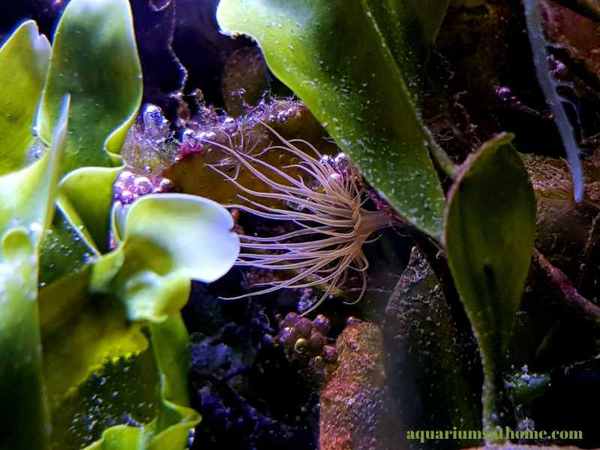
Do Snails Eat Aiptasia?
Certain species of snail or sea slug like berghia nudibranches will feast on aiptasia. They’re tiny so they can search out and destroy even the smallest fragments of aiptasia, leaving no trace of the pest behind to reproduce in a reef tank. Easy to care for and reef safe, these crustaceans do well in just about any marine tank with plenty of food and good water quality.
Conclusion
To sum things up, the safest, chemical-free way to rid your reef tank of pesky aiptasia is to add some peppermint shrimp to the aquarium. These small omnivorous crustaceans are hardy, easy to care for, and will eat almost anything edible, including aiptasia. Copperheaded butterfly fish and marine sea slugs like berghia nudibranches can also help keep a reef tank aiptasia-free.
I hope this article has been of help to you in deciding how best to remove unwanted aiptasia from your saltwater tank. Thanks for reading and good luck!
Recommended Posts
Best Shrimp for a Reef Tank (Top 10 Picks)
Best Inverts for a Nano Reef Tank
Reef Safe Fish for a 55 Gallon Tank?
Reef Safe Fish for 30 Gallon Tank



